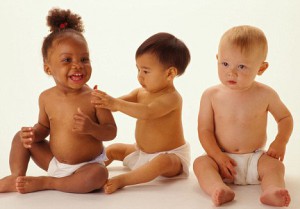“She’s ugly”, declared 2½-years-old Elizabeth, pointing to a picture of a baby on a diaper box.
“Why do you think so?” asked her shocked babysitter, Blair, gazing at the flawlessly beautiful, black baby. “I think she’s adorable.”
“Her skin is ugly,” Elizabeth told her. “Looks like monkey.”
Horrified by the child’s apparent racism, Blair concluded that the child’s mother must have made racist comments to Elizabeth. Blair, who also had darker skin with her black, white, and Native American ancestry, immediately felt uncomfortable.
Parents often incorrectly believe that if they don’t talk to their kids about race, their kids will grow up “color blind”. Unfortunately, staying silent on skin color doesn’t tell kids that we don’t notice race, it tells them that we don’t talk about it. And, then kids assign meaning to skin color on their own. While a conversation about skin color may feel intimidating, it’s important—here are some tips on how you can support positive racial attitudes in your kids:
- Encourage friendships. Make sure your kids have opportunities to form positive relationships with kids of other races. “Friendships are a major mechanism for promoting acceptance and reducing prejudice,” Deborah Rivas-Drake, a Psychologist at University of Michigan, explains. Friendships help kids to learn about people without relying on stereotypes. Likewise, parents can model a diverse network of friends to also promote diversity to their kids.
- Answer questions. If your child asks you a surprising or even offensive question about race, try not to hush them or dodge the question. Beverly Tatum, former President of the Spelman College of in Atlanta and author of Why Are All the Black Kids Sitting Together in the Cafeteria: And Other Conversations About Race
, suggests using the opportunity to talk about race. For example, if your child makes an embarrassing comment about someone’s skin looking “dirty”, Tatum suggests responding, “Honey, that little girl is not dirty. Her skin is as clean as yours. It’s just a different color. Just like we have different color hair, people have different skin colors”.
- Discourage labeling and generalizing. If you or other adults in your child’s life make generalizations about people based on race (for example, “black people are tough”), your child will mirror that behavior. “Send the message that it’s not OK to judge a person by a group,” suggests Marguerite Wright, Psychologist and author of I’m Chocolate, You’re Vanilla: Raising Healthy Black and Biracial Children in a Race-Conscious World
.
- Point out similarities. Kids form an in-group bias, starting at a very young age, meaning they prefer people of a group they also belong to. Sociologists, Debra Van Ausdale and Joe Feagin, observed that children as young as 3-years-old, excluded kids from play based on their race, as they describe in their book, The First R: How Children Learn Race and Racism
. You can use the in-group bias to your advantage though, for example, by pointing out that a little girl, who has a different color of skin, also seems to really like playing with dolls.
- Avoid staying silent on skin color. Many people, who genuinely want to teach their kids equality, feel uncomfortable talking about skin color. As described in the book NurtureShock: New Thinking About Children
, a University of Texas Ph.D. student recruited 100 families with young kids and asked them to show multi-cultural themed kids’ videos and/or to discuss interracial friendship. Five families dropped out immediately, and most only made general statements to their kids, like “everyone’s equal”, despite receiving talking points as part of the study. Tests found the kids thought black people were meaner than whites, and they either thought their parents didn’t like blacks or didn’t know if their parents like blacks. Only six families had the real conversations—and those six kids showed dramatically improved racial attitudes after just one week. So, although it’s scary to talk about, it’s impactful. To have a “real” conversation with your kids, you could tell your children that doctors can be any skin color, you could point out President Obama’s brown skin, or you could say, “Anyone can become a leader, and anyone—regardless of skin color—can be a friend, be loved and be admired.”
Taking this one step further, another approach is to teach kids to see every skin color—as beautiful. Instead of trying to teach kids to ignore skin color, which comes with beauty and culture, we could focus on teaching kids that they shouldn’t judge people or treat them differently, based on their skin color.
Whichever approach fits your family, have you talked to your children about race, yet? It may be an intimidating topic, but, by the time your kids are three, if you haven’t had a real conversation about race, they are probably already demonstrating racial prejudice.
Not sure where to start? Maybe you can try starting with something like, “Eyes and hair come in different colors, but they don’t determine how smart or nice a person is. The same is true with skin color”. Then you can fill in the rest by talking about your values and friendships.
After all, wouldn’t you rather shape your child’s views on skin color, than leave them guessing and forming negative opinions, like baby Elizabeth did? Years after the babysitting incident, Blair, now a mother, was a shocked to learn what Elizabeth’s parents probably really said to her about race: nothing.
To see more from Mama Lovejoy, “like” my Facebook page or follow me on Twitter, Tumblr or Instagram @Mamalovejoy1.
�
